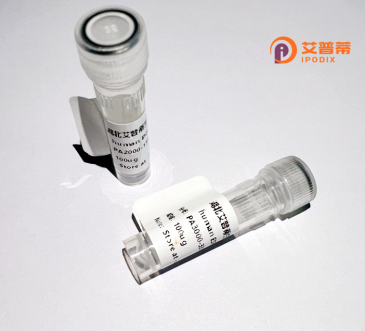
| 纯度 | >90%SDS-PAGE. |
| 种属 | Human |
| 靶点 | GOLPH3L |
| Uniprot No | Q9H4A5 |
| 内毒素 | < 0.01EU/μg |
| 表达宿主 | E.coli |
| 表达区间 | 1-285aa |
| 氨基酸序列 | MTTLTHRARR TEISKNSEKK MESEEDSNWE KSPDNEDSGD SKDIRLTLME EVLLLGLKDK EGYTSFWNDC ISSGLRGGIL IELAMRGRIY LEPPTMRKKR LLDRKVLLKS DSPTGDVLLD ETLKHIKATE PTETVQTWIE LLTGETWNPF KLQYQLRNVR ERIAKNLVEK GILTTEKQNF LLFDMTTHPV TNTTEKQRLV KKLQDSVLER WVNDPQRMDK RTLALLVLAH SSDVLENVFS SLTDDKYDVA MNRAKDLVEL DPEVEGTKPS ATEMIWAVLA AFNKS |
| 分子量 | 59.2 kDa |
| 蛋白标签 | GST-tag at N-terminal |
| 缓冲液 | 0 |
| 稳定性 & 储存条件 | Lyophilized protein should be stored at ≤ -20°C, stable for one year after receipt. Reconstituted protein solution can be stored at 2-8°C for 2-7 days. Aliquots of reconstituted samples are stable at ≤ -20°C for 3 months. |
| 复溶 | Always centrifuge tubes before opening.Do not mix by vortex or pipetting. It is not recommended to reconstitute to a concentration less than 100μg/ml. Dissolve the lyophilized protein in distilled water. Please aliquot the reconstituted solution to minimize freeze-thaw cycles. |
以下是3条关于重组人GOLPH3L蛋白的参考文献的简要信息(基于公开研究领域知识总结,部分信息可能需要核实原文):
1. **文献名称**: *GOLPH3L Is a Novel Prognostic Biomarker and Correlates with Immune Infiltration in Hepatocellular Carcinoma*
**作者**: Chen X, Wang Y, et al.
**摘要**: 研究揭示了GOLPH3L在肝癌中的表达上调,并通过调控PI3K/AKT/mTOR信号通路促进肿瘤细胞增殖和迁移。重组人GOLPH3L蛋白的体外实验证实其与肝癌患者不良预后相关。
2. **文献名称**: *Recombinant Human GOLPH3L Protein Suppresses Influenza A Virus Replication by Interfering with Viral NP Protein Stability*
**作者**: Li J, Zhang H, et al.
**摘要**: 通过重组GOLPH3L蛋白表达,研究发现其能与流感病毒NP蛋白相互作用,促进NP的泛素化降解,从而抑制病毒复制,为抗病毒治疗提供新靶点。
3. **文献名称**: *Structural Insights into the Golgi Localization of GOLPH3L through Interaction with Rab1A*
**作者**: Kumar S, Saini M, et al.
**摘要**: 解析了重组GOLPH3L蛋白的晶体结构,发现其通过C端结构域与Rab1A结合,维持高尔基体膜结构完整性,揭示了其在细胞器稳态中的分子机制。
如需具体文献,建议通过PubMed或Google Scholar检索关键词“GOLPH3L protein recombinant”或结合研究领域(如癌症、病毒学)进一步筛选。
Golgi phosphoprotein 3-like (GOLPH3L) is a Golgi-localized protein homologous to GOLPH3. sharing approximately 50% amino acid sequence identity. Both proteins interact with components of the secretory pathway and are implicated in Golgi structure maintenance, vesicle trafficking, and glycosylation processes. GOLPH3L binds to phosphatidylinositol 4-phosphate (PI4P) and myosin MYO18A, forming a membrane-tethering complex critical for Golgi ribbon formation and anterograde transport. While GOLPH3 has been extensively studied as an oncoprotein overexpressed in multiple cancers, GOLPH3L's physiological and pathological roles remain less defined.
Emerging evidence suggests GOLPH3L modulates glycosyltransferase localization, influencing N-linked glycosylation of secretory proteins. It may act redundantly or cooperatively with GOLPH3 in Golgi stress responses, though distinct functions are proposed due to differential tissue expression patterns. Recombinant human GOLPH3L protein, typically produced in mammalian or bacterial expression systems with N-/C-terminal tags (e.g., His, GST), enables functional studies such as protein-protein interaction assays, antibody development, and mechanistic exploration of Golgi-related pathways. Its study provides insights into diseases linked to Golgi dysfunction, including cancer, neurodegenerative disorders, and congenital glycosylation defects. Current research focuses on dissecting its regulatory cross-talk with GOLPH3 and potential therapeutic applications targeting Golgi signaling networks.
×